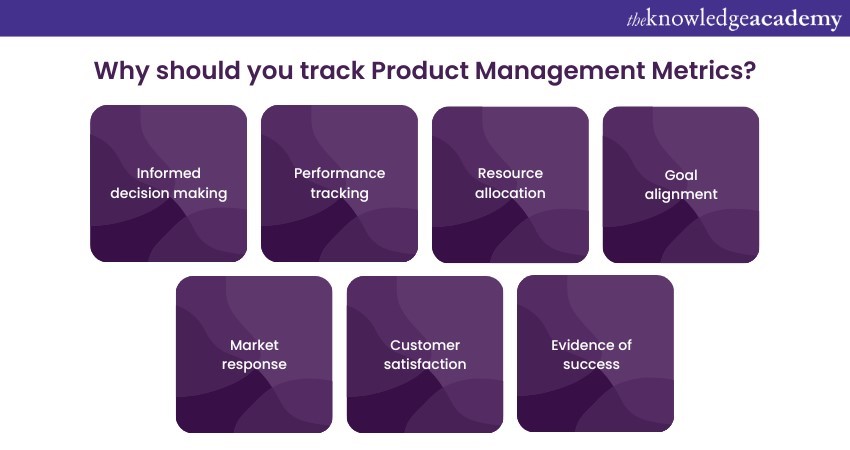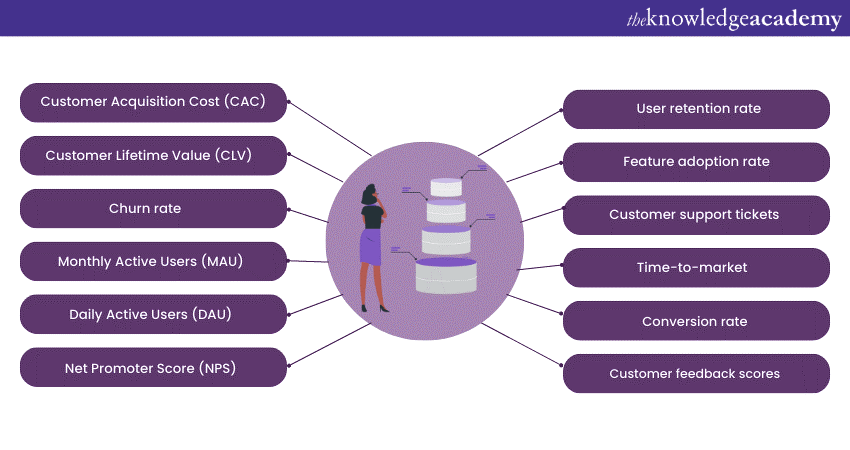We may not have the course you’re looking for. If you enquire or give us a call on +44 1344 203 999 and speak to our training experts, we may still be able to help with your training requirements.
Training Outcomes Within Your Budget!
We ensure quality, budget-alignment, and timely delivery by our expert instructors.

Effective Product Management is crucial in every business organisation. Product Management Metrics enable Product Manager to monitor product growth and customer satisfaction effectively. Choosing the right metrics to track performance is essential. Understanding and implementing these metrics are key aspects of a Product Manager's roles and responsibilities, ensuring the successful development and management of a product throughout its lifecycle. This blog will provide a detailed look into 12 key Product Management Metrics.
If you're unsure about which Product Management Metrics are best, then this blog is for you. We will provide detailed insights into various KPIs, helping you make decisions to enhance your product's performance.
Table of Contents
1) What is Product Management Metrics?
2) Why should you track Product Management Metrics?
3) Top 12 Product Management Metrics and KPIs
a) Customer Acquisition Cost (CAC)
b) Customer Lifetime Value (CLV)
c) Churn rate
d) Monthly Active Users (MAU)
e) Daily Active Users (DAU)
f) Net Promoter Score (NPS)
g) User retention rate
h) Feature adoption rate
i) Customer support tickets
j) Time-to-market
k) Conversion rate
l) Customer feedback scores
4) Conclusion
What is Product Management Metrics?
Product Management Metrics refer to the Key Performance Indicators (KPIs) and measurable data points used to assess and examine the success of a product or a product portfolio. This allows product managers to gather essential information about overall product performance.
Covering various points of the product lifecycle, from development and launch to ongoing usage and customer satisfaction, these help Product Managers make data-driven decisions, prioritise their efforts, and identify areas for changes to improve product performance.
Why should you track Product Management Metrics?
Tracking Product Management Metrics is essential for steering products towards success and ensuring they meet market demands and customer needs. Here is why they are important.

a) Informed decision making: Metrics provide tangible data that can guide decision-making processes. Instead of depending on gut feelings or assumptions, metrics offer concrete evidence that can help in making more strategic choices.
b) Performance tracking: By measuring various aspects of a product’s performance, such as user engagement or feature adoption, teams can identify what’s working well and what needs improvement. This ongoing evaluation helps maintain a product’s health and competitiveness.
c) Resource allocation: Metrics help determine where to allocate resources most effectively. Understanding which areas of a product are generating the most value can lead to more efficient use of time, money, and manpower.
d) Goal alignment: They ensure that everyone in the team—from development to marketing—is aligned with the overall product goals. Metrics acts as a common language that can help keep all team members on the same page.
e) Market response: They provide insights into how the market reacts to a product. This can be crucial for adapting to changes in market conditions and consumer preferences, thus avoiding costly missteps.
f) Customer satisfaction: Regular monitoring of satisfaction metrics can alert teams to potential issues before they escalate, allowing for proactive management and better customer retention.
g) Evidence of success: Finally, metrics can showcase the success of a product to stakeholders. Quantifiable achievements can bolster confidence among investors and within the team, encouraging continued support and investment.
Top 12 Product Management Metrics and KPIs

Customer Acquisition Cost (CAC)
Customer Acquisition Cost (CAC) is a critical Product Management Metric that helps product managers measure the effectiveness of their marketing and sales strategy. They study the costs of acquiring new customers. CAC enables Managers to fine-tune their acquisition efforts, thereby assuring a good Return on Investment (ROI).
Through reducing CAC, product managers are able to raise the product’s profitability and sustainability, the prerequisites of running a successful business. Furthermore, the comparison of CAC with Customer Lifetime Value (CLV) offers deeper understanding of the effect of customer acquisition on traction and profit. Tracking and examining CAC play key roles in strategic planning and resource distribution.
Customer Lifetime Value (CLV)
Customer Lifetime Value (CLV) determines the customer's worth to a firm for the whole term of their relationship. The calculation of CLV provides unparalleled insights into the revenue a customer is projected to generate as they continue their business with the company. This indicator is important for effective strategic decisions and resource management.
CLV being at the center allows Product Managers to identify the most valuable ones, driving their involvement and engagement to achieve higher long-term returns. Businesses can determine the ROI of their marketing effort by comparing CLV with the costs of customer acquisition. These parameters like customer spending pattern, purchase frequency and product lifespan are significant to determine the CLV, which in turn directs the targeted marketing campaigns.
Churn rate
Churn rate metric shows customer satisfaction by determining the percentage of people who drop the use of a product or service for a given period. This measure shows the performance of the business' products and customer experience.
Churn rate can reveal problems with product, customer support or overall satisfaction which obligates product managers to make improvements. By cutting the churn rate, it not only affects the revenue positively by retaining the previous clients but also enhances the company’s brand reputation and customers’ satisfaction. Happier customers in turn may recommend the product, creating a long circle of growth and positive feedback.
Monthly Active Users (MAU)
Monthly Active Users (MAU) provides valuable insights into a product's popularity among its user bases. It tracks the number of unique users who actively engage with the product during a specific month, offering product managers a clear picture of user activity and interest.
MAU is useful for assessing user retention and measuring the product's likability. A growing MAU count suggests that the product is retaining users and maintaining their interest over time. Conversely, a declining MAU may signal potential issues, such as a need for product updates or improvements.
MAU also serves as a benchmark for evaluating the impact of marketing and promotional activities. By comparing MAU trends before and after marketing campaigns, product managers can determine the effectiveness of their plans in attracting and retaining users.
Daily Active Users (DAU)
Daily Active Users (DAU) metric provides product managers with valuable insights into user engagement on a daily basis. Similar to Monthly Active Users (MAU), DAU helps assess the frequency and intensity of user interactions with the product.
A high DAU count indicates that users find the product valuable and relevant enough to use it regularly. High user engagement is a positive sign of the product's overall success and popularity. It also means that the product effectively meets user needs, leading to continuous usage and satisfaction.
Learn essential logistics principles and strategies with our Logistics Management Course – join today!
Monitoring DAU trends comes in handy in competitive markets where user attention is minimal . Consistently tracking DAU helps Product Managers identify any drop in user engagement quickly. After analysing the reasons behind a decline in DAU, Product Managers can take measures to address issues and keep users engaged.
Net Promoter Score (NPS)
Net Promoter Score (NPS) is a Key Performance Indicator (KPI) that measures customer commitment and contentment. It asks customers, "How likely are you to suggest our product to others?" Customers are categorised as promoters (score 9-10), passives (score 7-8), or detractors (score 0-6).
A high NPS indicates many promoters and high customer satisfaction. These promoters are likely to recommend the product, driving organic growth and positive word-of-mouth. Conversely, a low NPS, with many detractors, suggests negative experiences that could harm sales and damage reputation.
Regularly tracking NPS helps product managers monitor customer sentiment and compare performance against industry benchmarks. Acting on NPS feedback by addressing customer pain points can improve the user experience (UX), enhance satisfaction, retain customers, and attract new ones.
User retention rate
User retention rate helps in understanding the effectiveness of the product in retaining customers over time. This KPIs check the percentage of users who continue to use the product over a specified period. It indicates the product's value and its overall user experience (UX).
A high user retention rate is a positive sign that users find the product relevant and satisfying enough to keep using it regularly. This metric indicates the level of product stickiness and customer loyalty, both of which are critical for long-term success and growth.
It is essential to find any potential issues or weaknesses in the product. If the retention rate is low, Product Managers can investigate the reasons behind it. It can be poor user experience (UX), missing features, or lack of ongoing support. Addressing these issues helps in improving user satisfaction and retention.
This KPI is also closely linked to Customer Lifetime Value (CLV). By retaining customers over an extended period, businesses can increase CLV and maximise the revenue potential of each customer.
Take the leap towards a successful supply chain career. Join our Supply Chain Management Training today!
Feature adoption rate
Product Managers use this key KPI feature adoption rate to see the success of new product features and their acceptance among users. Tracking the adoption rate of newly introduced features provides valuable feedback on their relevance and impact on user experience.
A high feature adoption rate indicates that users find the new features valuable and beneficial. It also suggests that the product team has successfully identified and addressed user needs through these new additions. On the other hand, a low adoption rate may signal that the features lack appeal or fail to meet user expectations.
Looking into feature adoption rates, product managers can allocate resources more efficiently. They can focus on developing and promoting features that connect well with users. It leads to increased customer satisfaction, commitment and retention.
Additionally, feature adoption rate insights can help product managers prioritise their action plans. By identifying popular features and those that require improvement, product teams can use resources and efforts, accordingly.
Customer support tickets
Customer support tickets provide insight into the issues users face with the product. Monitoring the number and types of tickets is crucial for gauging customer feedback and satisfaction. A high volume of tickets may point to product areas needing improvement or features requiring clarification. Analysing ticket categories helps Product Managers spot common issues and trends.
Prompt responses to customer support tickets enhance brand reputation and customer loyalty. It is crucial for building trust and encouraging users to stay loyal and recommend the product.
This data also informs potential areas for new features or improvements. By incorporating user feedback into the development process, product Mmnagers can create a more user-centric product.
Time-to-market
Time-to-market measures the time taken from the inception of a new product to its successful launch in the market. A shorter time to market is good for businesses as it allows them to quickly meet market demands and gain a competitive edge. Products that are brought to market faster have a higher likelihood of capturing market share than competitors.
Efficient time-to-market is also essential for meeting customer needs. By reducing development time, Product Managers can ensure that the product remains relevant to changing customer preferences. It results in higher customer satisfaction.
Tracking time-to-market helps Product Managers identify loopholes and inefficiencies in the product development process. By identifying areas that cause delays, product teams can implement process improvements and stabilise workflow. It is more of a responsive process to increase business profitability.
Conversion rate
The conversion rate is crucial for both product managers and marketers. It evaluates the percentage of users who complete a desired action, like signing up for a service or making a purchase. This is vital for evaluating the effectiveness of marketing efforts and overall user experience.
A high conversion rate suggests that users are actively engaging with the product and responding well to calls to action, indicating a good alignment between the product's value proposition and user expectations. It also reflects the success of marketing strategies in driving conversions.
Conversely, a low conversion rate may point to issues with the product or marketing approach, signalling that they are not motivated or convinced to take the desired action. This prompts product managers to investigate and address potential pain points or areas for improvement.
Monitoring conversion rates at different phases of the user journey is important. Analysing helps product managers identify barriers that prevent users from progressing and allows them to optimise the user experience (UX) and streamline the conversion process, ultimately boosting business.
Customer feedback scores
Customer feedback scores are a valuable source of information, offering deep insights into the strengths and weaknesses of a product. By systematically collecting and analysing feedback through surveys, reviews, and feedback forms, product managers gain an understanding of user perceptions, preferences, and pain points.
These scores, often based on a rating scale, reflect various aspects of the product like usability, features, and customer support. Positive feedback scores indicate the product's strengths and customer satisfaction, while negative scores highlight areas needing improvement.
This feedback allows Product Managers to pinpoint specific issues and make necessary updates, enhancing the user experience. It also helps in understanding user sentiments and spotting emerging trends, which are crucial for developing future product strategies.
Conclusion
With the advancement in technology and the ever-evolving business sphere, it is vital to stay updated with the latest tools. We hope the blog gave you an understanding of the 12 best Product Management Metrics and the purposes of each tool. These KPIs, when used effectively, can bring exponential growth to your business.
Understand current trends and technologies with our Industry Course – join today!
Frequently Asked Questions

Choosing the right metrics for your product involves finding the Key Performance Indicators (KPIs) that align with your business goals and provide insights into customer satisfaction and product performance.

One common mistake to avoid when tracking Product Management Metrics is focusing too heavily on vanity metrics that don't directly influence or reflect the product's actual performance and customer value.

The Knowledge Academy takes global learning to new heights, offering over 30,000 online courses across 490+ locations in 220 countries. This expansive reach ensures accessibility and convenience for learners worldwide.
Alongside our diverse Online Course Catalogue, encompassing 17 major categories, we go the extra mile by providing a plethora of free educational Online Resources like News updates, Blogs, videos, webinars, and interview questions. Tailoring learning experiences further, professionals can maximise value with customisable Course Bundles of TKA.

The Knowledge Academy’s Knowledge Pass, a prepaid voucher, adds another layer of flexibility, allowing course bookings over a 12-month period. Join us on a journey where education knows no bounds.

The Knowledge Academy offers various Industry Training Course, including Facilitation Skills Course, Product Management Course and Supply Chain Management Course. These courses cater to different skill levels, providing comprehensive insights into Supervisor Decision Making.
Our Business Skills Blogs cover a range of topics offering valuable resources, best practices, and industry insights. Whether you are a beginner or looking to advance your IT Security skills, The Knowledge Academy's diverse courses and informative blogs have you covered.
Upcoming Business Skills Resources Batches & Dates
Date
 Facilitation Skills Training
Facilitation Skills Training
Fri 21st Jun 2024
Fri 2nd Aug 2024
Fri 18th Oct 2024
Fri 20th Dec 2024









 Top Rated Course
Top Rated Course



 If you wish to make any changes to your course, please
If you wish to make any changes to your course, please


